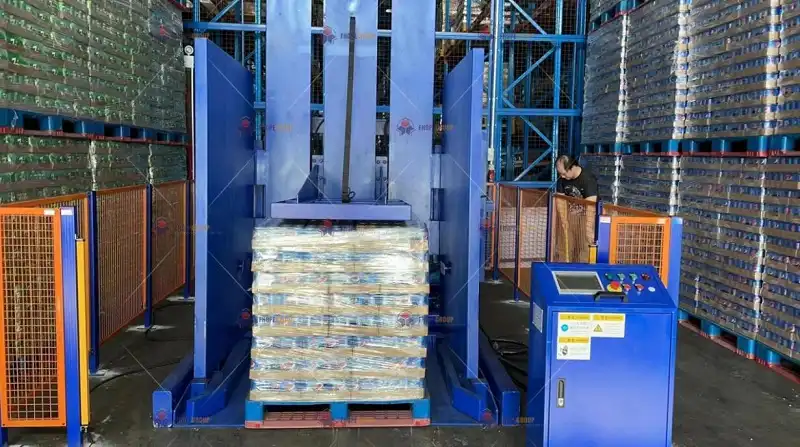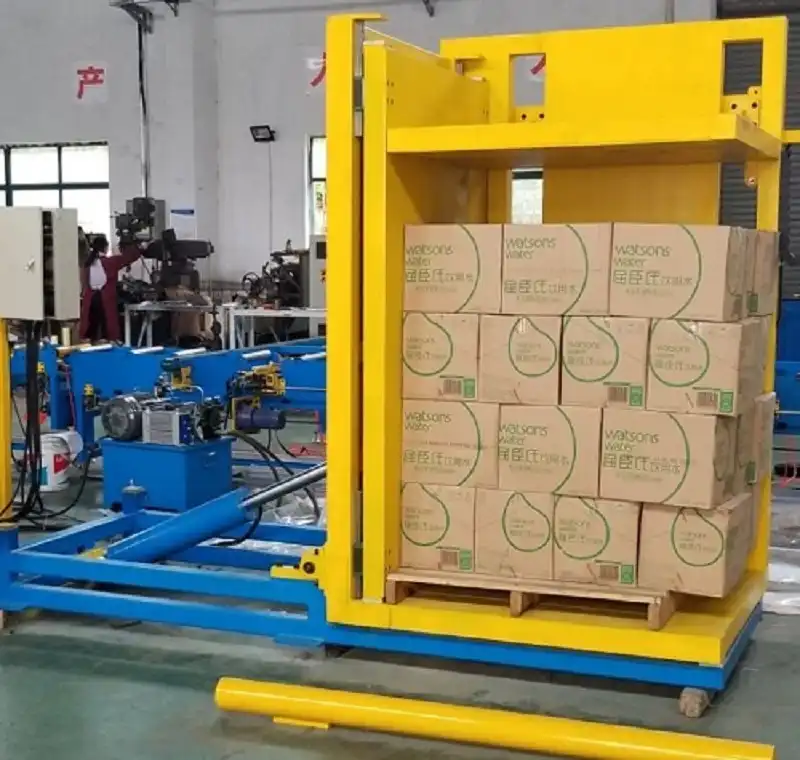Pallet Inverters and Workplace Safety: Building a Strong Case for Investment

Pallet inverters are sophisticated material handling tools that represent a crucial investment for businesses aiming to significantly enhance workplace safety while boosting operational efficiency. Faced with the persistent risks of manual handling and the need for streamlined logistics, pallet inverters offer a practical solution. They effectively minimize physical hazards associated with load manipulation, simplify complex handling processes, and contribute directly to improved productivity. This article examines the integral role of pallet inverters in promoting workplace safety and outlines a strategic approach for building a compelling investment case.
1. The Critical Role of Pallet Inverters in Enhancing Workplace Safety
Fundamentally, a pallet inverter automates the process of rotating or inverting heavy palletized loads, requiring minimal direct human effort. This automation is key to reducing reliance on manual pallet handling – tasks notorious for being physically demanding and inherently risky. Industries such as warehousing, logistics, manufacturing, and distribution frequently grapple with injuries stemming from the manual loading, unloading, stacking, and repositioning of pallets.
Data from safety authorities like the Occupational Safety and Health Administration (OSHA) consistently highlights overexertion, awkward postures, and repetitive motions associated with manual material handling as major contributors to workplace injuries, particularly musculoskeletal disorders (MSDs). By integrating pallet inverters, companies proactively mitigate these risks, fostering a safer environment and reducing the likelihood of costly strains, sprains, and accidents. Find more information on safe material handling guidelines from OSHA's official resources.

2. Understanding the Hazards of Manual Pallet Handling
To truly appreciate the safety benefits of pallet inverters, it's vital to recognize the specific dangers workers face when handling pallets manually:
- Musculoskeletal Injuries (MSDs): Frequent bending, twisting, lifting heavy or awkward loads dramatically increases the risk of acute and chronic back pain, shoulder injuries, and other MSDs. These are leading causes of lost work time and workers' compensation claims.
- Crushing and Impact Hazards: Unstable loads or improperly handled pallets can shift, tip, or collapse, potentially causing severe crushing injuries to workers nearby.
- Slips, Trips, and Falls: Manoeuvring heavy pallets manually, often in busy or congested areas, increases the risk of slips, trips, and falls, which can lead to various injuries.
- Repetitive Strain Injuries (RSIs): The repetitive nature of lifting, carrying, and placing pallets can lead to RSIs affecting the wrists, arms, shoulders, and back over time.
Implementing pallet inverters directly addresses these hazards by automating the most strenuous and risky parts of the task, making ergonomic solutions a cornerstone of modern warehouse safety protocols.
3. Operational Mechanism: How Pallet Inverters Function
Pallet inverters operate by securely clamping a palletized load and rotating it, typically 180 degrees, though some models offer 90-degree or variable rotation. This controlled inversion allows for tasks like:
- Replacing Damaged Pallets: Quickly and safely swapping broken or unsuitable pallets without manually destacking and restacking goods.
- Transferring Loads: Moving goods between different pallet types (e.g., wood to plastic/hygienic pallets) as required for specific industries or shipping regulations.
- Enabling FIFO Systems: Easily rotating stock, particularly perishable goods, to ensure adherence to first-in, first-out inventory management principles.
- Improving Load Stability: Adjusting or reorienting loads for safer storage or transport.
Modern pallet inverters are designed for smooth, reliable operation and can be configured to handle a wide range of load dimensions, weights, and types, offering essential flexibility across various industrial applications. They effectively automate repetitive, high-risk tasks, reducing manual labor demands and safeguarding the workforce.

4. Constructing a Solid Business Case for Investment
Investing in pallet inverter technology transcends safety improvements; it is a strategic move towards enhanced operational efficiency and significant cost reduction. Here’s how to build a persuasive case:
- Quantifiable Reduction in Workplace Injuries: Demonstrate how pallet inverters directly mitigate manual handling risks. Fewer injuries translate directly into lower workers' compensation claims, reduced insurance premiums, minimized lost workdays, and improved employee morale. These savings can be substantial over the equipment's lifespan.
- Measurable Productivity Gains: Automating pallet handling tasks drastically cuts down the time and labor required compared to manual methods. Calculate the time saved per pallet exchange or rotation and extrapolate this across daily operations. This frees up valuable employee time for higher-value activities, boosting overall throughput and reducing operational bottlenecks.
- Attractive Return on Investment (ROI): While there's an initial capital outlay, the long-term savings from reduced injury costs, lower labor requirements per task, decreased product damage during handling, and increased process speed typically result in a compelling ROI. Project these savings over several years to illustrate the financial benefits.
- Enhanced Compliance and Reputation: Utilizing pallet inverters helps ensure compliance with OSHA and other relevant manual handling regulations, avoiding potential fines and legal issues. Furthermore, investing in advanced safety technology enhances the company's reputation as a responsible employer committed to worker well-being.
5. Evidence of Impact: Real-World Benefits Observed
To substantiate the investment case, highlight tangible outcomes reported by companies utilizing pallet inverters:
- Drastically Reduced Pallet Exchange Times: Businesses, particularly those with high inventory turnover (e.g., food & beverage, pharmaceuticals), report significant reductions in the time taken to swap or invert pallets, leading to smoother workflows.
- Demonstrably Safer Work Environments: Numerous organizations across logistics, manufacturing, and distribution sectors have documented sharp declines in manual handling injuries post-implementation, sometimes exceeding 50%, fostering a culture of safety.
- Minimized Product Damage: Automated, controlled handling reduces the likelihood of goods being dropped or damaged during transfer, leading to less waste and associated costs, especially critical for fragile or high-value items.
These real-world results underscore the strategic value of pallet inverters in creating more efficient, safer, and cost-effective operations.

6. Key Considerations When Selecting a Pallet Inverter
Choosing the right pallet inverter requires careful assessment of specific operational needs. Consider these key factors:
- Required Load Capacity: Ensure the machine's weight capacity comfortably exceeds the heaviest loads your facility handles regularly.
- Rotation and Handling Needs: Determine the necessary degree of rotation (90°, 180°, variable). Consider specific handling requirements like floor-level loading, freezer environment compatibility, or integration with conveyor systems.
- Built-in Safety Features: Prioritize models with robust safety mechanisms, such as secure clamping systems, pressure controls, safety fencing or light curtains, and accessible emergency stops.
- Ease of Use and Maintenance: Evaluate the user interface, training requirements, and the manufacturer's support and maintenance provisions.
- Footprint and Integration: Assess the physical space required for the machine and how it will integrate into your existing workflow and facility layout.
- Customization Potential: Explore options for customization if standard models don't perfectly match unique requirements (e.g., specific load dimensions, automation integration).
Selecting a pallet inverter tailored to your specific operational context ensures maximum return on investment in terms of both safety and efficiency.
Conclusion: Pallet Inverters as a Strategic Investment for Safety and Efficiency
Pallet inverters provide a robust, multifaceted solution to persistent challenges in modern material handling and warehouse environments. By dramatically reducing the risks inherent in manual pallet handling, they directly contribute to improved workplace safety. Simultaneously, they streamline operations, boost productivity, and reduce associated costs, making them a powerful tool for optimizing efficiency.
When advocating for investment in pallet inverters, emphasize the compelling combination of reduced injury rates, tangible cost savings, productivity enhancements, and assured regulatory compliance. Presenting these benefits with clear data and operational context makes a powerful case for decision-makers. In today's increasingly competitive and safety-conscious landscape, investing in proven safety-enhancing technologies like pallet inverters is not merely an option but a strategic imperative for forward-thinking companies aiming to protect their workforce, optimize logistics, and strengthen their bottom line.